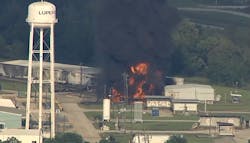Nov. 15--Prior to the chemical fire at its Crosby plant, Arkema underestimated the potential for storm damage and failed to keep essential backup power protected from rising floodwaters, documents obtained by the Houston Chronicle show.
Poor planning and a series of cascading equipment failures led to dangerous chemicals erupting into flames in late August during the height of Hurricane Harvey. The miscalculations indicate the company's lack of preparation for more than 3 feet of flooding, reflected by an emergency management plan that barely addressed how to handle such a storm.
Those judgments led to the burning of nine trailers containing the company's stockpile of organic peroxides. The resulting inferno exposed first responders and local residents to dangerous fumes and pulled emergency staffers away from hurricane recovery at a critical time.
Arkema officials argue that unprecedented floods made it impossible to prevent its chemicals from catching fire. The site had only seen up to 2 feet of flooding in the past, company officials said.
The Chronicle obtained Arkema's internal records from the U.S. Environmental Protection Agency and conducted interviews with government employees with knowledge of ongoing investigations of the events at the plant. The emerging picture reveals nine days of chaos, culminating with the decision to intentionally burn chemicals that posed a danger to the public.
The records, obtained through the Freedom of Information Act, and interviews show that:
- Arkema's emergency response plan provided employees with little direction for how to handle major flooding events. It contained one paragraph about flooding but a page and a half on handling bomb threats, records show.
- Arkema's main power transformers and its powerful backup generators were not high enough off the ground, causing them to become submerged with floodwaters, Arkema records show. Without power, the company could not keep its stash of organic peroxides at a safe temperature inside its refrigerated buildings.
- The company's last resort for keeping organic peroxides cool -- refrigerated trailers -- also was destined to fail. The diesel-powered trailers had fuel tanks that ran along the bottom of the vehicle. More than 3 feet of water compromised the fuel tanks, causing the freezers to die.
- Arkema had a tank of an extremely dangerous chemical, isobutylene, located about 40 yards from six trailers that had been relocated during the storm, according to interviews and satellite images. Government officials were concerned about a chain reaction with that chemical that could have led to catastrophic results.
Arkema officials said again Tuesday that no amount of planning could have protected its site from the storm.
"Many of your conclusions fail to recognize that Hurricane Harvey was unlike any rain event Houston ever experienced," company spokeswoman Janet Smith said in an email. "FEMA's 500-year flood map doesn't address the situation that occurred during Hurricane Harvey."
Four days after Harvey made landfall in Texas, the Arkema plant was under 7 feet of water. The last employees to evacuate the site left by boat, floating over a 6-foot chain-link fence topped by barbed wire, the records show.
"Flooding in Houston is a perfectly foreseeable event," said Paul Orum, an independent Washington, D.C., consultant and longtime chemical safety advocate. "Facilities should be prepared when it comes to several different layers of flooding."
Lines laid low
Arkema, a French multinational company, manufactures chemicals used to create plastic products. Many of its proprietary compounds are classified as organic peroxides, which must be kept at temperatures well below freezing to prevent the chemicals from catching fire.
With Hurricane Harvey bearing down on Southeast Texas and the National Hurricane Center warning of potentially "catastrophic" or "life-threatening" flooding, the company's plans for protecting its product were simple: keep the chemicals cold on-site.
The company had multiple freezer buildings, six backup generators, and, as a last resort, refrigerated trucks. Documents provided to the Chronicle did not indicate any plans to drive the organic peroxides away from Harvey's impact.
But Arkema's plan for Harvey was based on one flawed assumption: that the site would never experience floods higher than 3 feet. By the end of the weekend, the rain had exceeded that total.
On the afternoon of Aug. 27, two days after the storm made landfall, Arkema employees riding out the storm became concerned that floodwaters would seep into the primary power transformers, according to the crew's logs. If that happened, the plan was to start the backup generators; one of them was connected to refrigerated buildings keeping the organic peroxides cold.
At the same time, employees were already aware that a backup liquid nitrogen system was useless after floodwaters reached the pipes that would pump freezing nitrogen into buildings.
Within 24 hours, the primary transformers and two generators powering the refrigerated buildings were inundated with floodwaters, records show.
In planning for catastrophic flooding, Arkema could have elevated its backup generators on platforms or placed them on roofs, said Rick Laine, a salesman for Cay Power Products Co. of Houston. Laine noted that it's rare, but not impossible, for generators to be placed on platforms several feet above the ground.
"We sometimes see them elevated that high in Galveston with the storm surge, but not in a place that's way out there like Crosby," Laine said.
By the night of Aug. 27, the 12 employees riding out the storm at Arkema were in a precarious position. Only one freezer building still had power. Their land lines were out. The internet was out. Water was about a foot away from the main transformers. They had already moved some of the peroxides into freezer trucks and used heavy equipment to relocate the trailers farther from the workers.
"This effort of our ride out crew has been nothing short of heroic," the crew's log reads.
But the crew's circumstances were only going to get worse.
A toxic cloud?
With the liquid nitrogen system down and backup generators inundated, the team spent most of Aug. 28 wading through floodwaters to move the remaining peroxides into refrigerated trailers, the documents show.
It was the last line of defense -- and one that was already failing.
As employees stuffed 48 pallets of organic peroxides into a trailer, two other freezer trailers died, crew logs show. Arkema told employees to move to the front of the site so they wouldn't be near the trailers if they caught fire, according to a family member of one of the workers.
The next day, Aug. 29, the workers were ordered to evacuate. Local government officials ordered everyone within 1.5 miles of the plant to leave, affecting about 300 homes. During the next two days, three refrigerated trailers lost the ability to cool the chemicals, causing the first fires that burned over Crosby.
The first fire started in the middle of the night of Aug. 31. Fumes from one trailer swept over the evacuation zone, where sheriff's deputies were patrolling. Law enforcement officers manning the perimeter and medical staff responding to the scene doubled over, vomiting and gasping for breath, according to a civil lawsuit filed against Arkema by the first responders. In all, 23 people were briefly hospitalized.
"The scene was nothing less than chaos," the lawsuit states.
Two more trailers caught fire on Sept. 1. Two days later, members of the Houston Police Department's bomb squad entered the site and placed charges on the side of the remaining six trailers. Officers remotely detonated the charges, creating enough heat to trigger the runaway reactions and burn out the remaining chemicals.
No public warning
It's not clear whether Houston police offered to do the mission or were asked to participate by other agencies overseeing the crisis.
The entire police operation was conducted without warning the public. Until the documents were released earlier this month by the EPA, the public didn't know who performed the controlled burn, or how it was done.
Ultimately, the bomb squad was successful. The evacuation zone was lifted that evening. First responders returned to helping with Harvey recovery and Crosby residents returned to their homes.
Throughout the blazes, Arkema and local officials said the fumes were not toxic. And Arkema downplayed the odds of other chemicals being affected by the flames.
Some government officials worried that a tank containing isobutylene, an extremely hazardous chemical, could fail when the organic peroxides burned, according to a source close to the investigation. An isobutylene tank failure could have triggered a chain reaction, taking out the company's sulfur dioxide tank and creating a toxic cloud. Arkema's risk-management plan said such a reaction could affect more than a million Houston-area residents.
The concern was so great that the bomb squad set fire to the remaining trailers farthest from the isobutylene first, just to be sure. The tank was not damaged and did not catch fire.
Multiple investigations continue into the Arkema fires. On Wednesday, the U.S. Chemical Safety Board will discuss its progress during a news conference.
___ (c)2017 the Houston Chronicle Visit the Houston Chronicle at www.chron.com Distributed by Tribune Content Agency, LLC.






